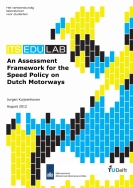Currently, the Dutch government aims to raise the speed limit to 130 km/h on as many motorways as possible. The reason for this is that current speed limits do not correspond with the wishes and expectations of the road user any more. For this new speed limit the local conditions and targets need to be taken into account. To deal with the location and time dependent circumstances (for instance air quality or traffic safety due to the traffic flow), a dynamic speed limit is an appropriate solution. At this moment, an integral approach which considers the significant factors (factors dependent of the chosen viewpoint in the speed limit determination) is not available in the Netherlands. A literature review on the state of the art developments concerning speed limits provides two different approaches for the assessment framework. These approaches are the engineering philosophy and the economic optimization philosophy. In the engineering philosophy a speed limit is determined by the highest possible speed that the roadway characteristics allow (called the upper bound). In the economic optimization philosophy an optimal speed limit is determined as the speed limit with the lowest cost for society, considering the significant factors. In this report the significant factors are the cost of travel time, the vehicle operating cost, the road accidents cost, the cost of traffic noise and the cost of air pollution.
The developed assessment framework distinguishes three steps. Step 1 describes the engineering philosophy, where the upper bound is determined. Step 2 contains the economic optimization philosophy. In this step an optimal speed limit is determined, with respect to the upper bound. Step 3 provides the comparison. The current speed limit is compared to the determined optimal speed limit, which leads to an advice. This advice consists of a permanent result (during all hours of the day) and a dynamic result (dependent of the traffic flow). In order to test the developed assessment framework in practice, a case study is performed. In the case study road sections located in the Dutch motorway network are applied in the developed assessment framework. With this evaluation the usefulness of the assessment framework in practice is determined.
The case study showed that the developed assessment framework provides a good working methodology for determining an optimal speed limit for a road section. Concluding, one can state that due to the unavailability of an integral approach in the setting of a speed limit, the economic optimization philosophy (with respect to the upper bound) is a proper way to deal with this. In this way, significant factors can be taken into account by determining the optimal speed limit. The comparison between the determined optimal speed limits and the current speed limits shows that in general the current speed limit should be changed. Either decreased or increased depends of the perspective: the road authority aims to decrease the current speed limit and the road user aims to increase the current speed limit. For the dynamic result, further research is needed whether or not the critical region on the fundamental diagram is reached in case of a speed limit decrease or a speed limit increase. Also, further research is needed to the implementation of the optimal speed limit. When the current speed limits needs to be changed (either permanent or dynamic), it is important to investigate how this new speed limit can be implemented and to make known the optimal speed limit (either permanent or dynamic) towards the road user.
